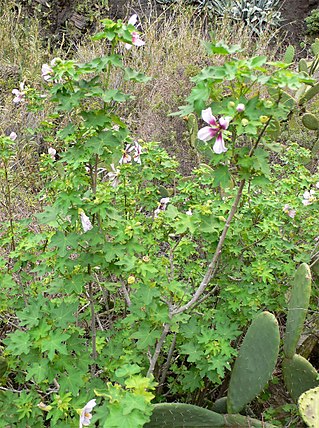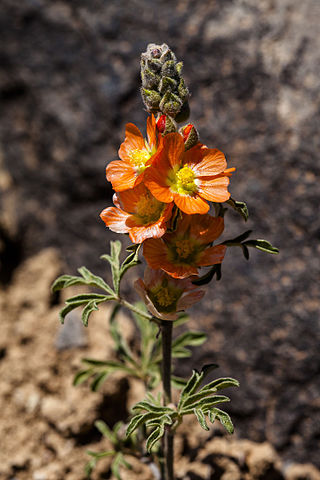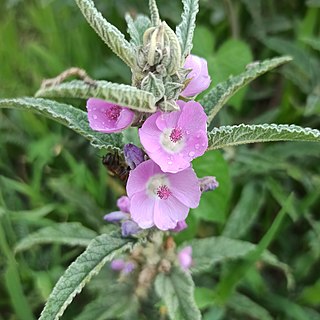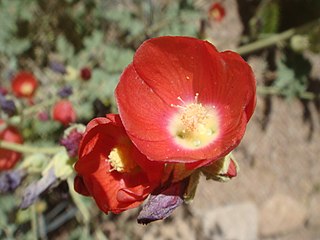
Abutilon is a large genus of flowering plants in the mallow family, Malvaceae. It is distributed throughout the tropics and subtropics of the Americas, Africa, Asia, and Australia. General common names include Indian mallow and velvetleaf; ornamental varieties may be known as room maple, parlor maple, or flowering maple. The genus name is an 18th-century Neo-Latin word that came from the Arabic ’abū-ṭīlūn, the name given by Avicenna to this or a similar genus.

Sphaeralcea is a genus of flowering plants in the mallow family (Malvaceae). There are about 40-60 species, including annuals, perennials, and shrubs. Most originate in the drier regions of North America, with some known from South America. They are commonly known as globemallows, globe mallows, false mallows or falsemallows. The name of the genus is derived from the Greek words σφαῖρα (sphaira), meaning "sphere," and αλκεα (alkea), meaning "mallow."

Malva moschata, the musk mallow or musk-mallow, is a species of flowering plant in the family Malvaceae, native to Europe and southwestern Asia, from Spain north to the British Isles and Poland, and east to southern Russia and Turkey. Growing to 60 cm (24 in) tall, it is a herbaceous perennial with hairy stems and foliage, and pink saucer-shaped flowers in summer.

Sphaeralcea incana, with the common names gray globemallow and soft globemallow, is a desert plant in the mallow family (Malvaceae).

Malva acerifolia, also frequently known under the synonyms Lavatera acerifolia or Malva canariensis is a shrub endemic to the Canary Islands, belonging to the family Malvaceae.

Malva alcea is a plant in the mallow family native to southwestern, central and eastern Europe and southwestern Asia, from Spain north to southern Sweden and east to Russia and Turkey.

Sphaeralcea coccinea, commonly known as the scarlet globemallow, scarlet mallow, cowboy's delight, prairie mallow, red false mallow, or simply as globe mallow is a perennial plant growing 10–30 cm tall from spreading rhizomes with a low habit. They have grayish stems with dense, star-shaped hairs and alternately arranged leaves. The leaf blades are 2–5 cm long, palmately shaped, and deeply cut, with 3–5 main wedge-shaped segments. The undersides of the leaves have gray hairs. The 1–2.5 cm wide flowers are reddish-orange and saucer-shaped, with 5 notched, broad petals, in small terminal clusters. It produces numerous stamen which surround the pistils as a tube. Plants flower from May to October in southern regions and May to July in northern regions. The plant produces a dry "fruit" called a schizocarp, which after maturity, breaks into roughly 10 or more seed segments.

Sphaeralcea ambigua, is a species of flowering plant commonly known as desert globemallow or apricot mallow, is a member of the genus Sphaeralcea in the mallow family (Malvaceae).

Sphaeralcea gierischii, Gierisch's globemallow or Gierisch mallow, is an endangered species of flowering plant in the mallow family, Malvaceae. It is native to the western United States, where it is known only from Utah and Arizona. It was described in 2002.

Montia parvifolia is a species of flowering plant in the family Montiaceae known by the common names little-leaf miner's lettuce, small-leaved blinks and small-leaved montia. It is native to western North America from Alaska to California to Montana, where it grows in moist to wet areas in several types of mountain habitat.

Sphaeralcea angustifolia is a species of flowering plant in the mallow family known by the common names copper globemallow and narrow-leaved globemallow. It is native to the southwestern United States as well as northern and central Mexico, where it grows in desert and plateau habitat. It produces many erect stems, approaching three meters in maximum height. It is woolly or felt-like in texture. The gray-green leaf blades are lance-shaped and measure up to about 5 cm long. They have wavy or slightly lobed edges. The leafy inflorescence bears several flowers each with five wedge-shaped orange petals just under 1 cm in length, and yellow anthers.

Sphaeralcea coulteri is a species of flowering plant in the mallow family known by the common name Coulter's globemallow. It is native to the Sonoran Desert, its distribution extending from northern Mexico north into California and Arizona. It is an annual herb, its slender, hairy stems sprawling or growing erect to a maximum height near 1.5 meters. The thin, gray-green leaf blades are wide and short, heart-shaped or triangular in shape, and measure up to about 5 centimeters long. They have a few wide lobes along the edges which may have teeth or smaller lobes. The leafy inflorescence bears clusters of flowers each with five wedge-shaped orange petals around a centimeter long, and yellow anthers.

Sphaeralcea emoryi is a species of flowering plant in the mallow family known by the common name Emory's globemallow. It is native to the Southwestern United States, California and Northwestern Mexico. It grows in desert habitat and sometimes disturbed areas such as roadsides.

Sphaeralcea grossulariifolia is a species of flowering plant in the mallow family known by the common name gooseberryleaf globemallow. It is native to the western United States, where it can be found in the Great Basin and surrounding regions. It grows in sagebrush, woodlands, playas, and the canyons of the upper Colorado River. It is common in disturbed areas, such as habitat recently cleared by wildfire.

Sphaeralcea munroana is a species of flowering plant in the mallow family known by the common names Munro's globemallow and Munro's desert-mallow. It is native to the western United States, where it can be found in the Great Basin and surrounding regions. It grows in sagebrush, desert flats, mountain slopes, and requires plenty of sunlight to thrive. This perennial herb produces erect stems up to about 80 centimetres (31 in) tall from a thick root system. It is woolly and gray-green in color. The alternately arranged leaves have triangular blades up to 6 cm long, usually edged with large lobes and a toothed margin. Flowers occur in clusters on a raceme-like inflorescence. The flower has five apricot to red-orange petals each just over 1 cm long.

Sphaeralcea rusbyi is a species of flowering plant in the mallow family known by the common names Rusby's globemallow and Rusby's desert-mallow. It is native to the southwestern United States, where it can be found in various types of desert habitat. The species is generally divided into three subtaxa which grow in separate sections of the desert southwest. In general, the plant produces hairy or woolly stems which can reach three meters tall. The leaves are lobed or compound. The flowers each have five red-orange petals up to 2 centimeters long.

Abutilon parishii is a species of flowering plant in the mallow family known by the common names Parish's Indian mallow and Pima Indian mallow. It is native to Arizona in the United States and Sonora in Mexico.
Malva pusilla, also known as Malva rotundifolia, the low mallow, small mallow, or the round-leaved mallow, is an annual and biennial herb species of the Mallow genus Malva in the family of Malvaceae. Malva is a genus that consists of about 30 species of plants. This genus consists of plants named mallows. Mallows grow in many regions, including temperate, subtropical, and tropical areas.

Noccaea fendleri more commonly known as wild candytuft and alpine pennycress is a wildflower in the mustard family from western North America. It grows in mountains from northern Mexico to the northern United States. It blooms early in the spring and provides nectar to butterflies.



















